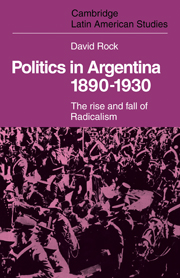Book contents
- Frontmatter
- Contents
- Preface
- 1 The components of Argentine society, 1890–1914
- 2 The oligarchy and institutional reform, 1880–1916
- 3 The rise of Radicalism, 1891–1916
- 4 The workers and their politics in Buenos Aires, 1890–1916
- 5 The first Radical government, 1916–22
- 6 The strikes, 1916–18
- 7 The Semana Trágica
- 8 1919
- 9 Postscript to the first presidency, 1920–2
- 10 The Alvear interlude, 1922–8
- 11 Yrigoyen's second presidency, 1928–30
- 12 Perspectives
- APPENDIXES
- 1 The occupational and class structure of the male population of the city of Buenos Aires by nationality, 1914
- 2 The rise of Radicalism – an historiographical note
- 3 The first Radical government and the Argentine Rural Society
- 4 The working class vote for the Radical and yrigoyenista parties in selected areas of Buenos Aires, 1912–30
- Select bibliography
- Index
- Frontmatter
- Contents
- Preface
- 1 The components of Argentine society, 1890–1914
- 2 The oligarchy and institutional reform, 1880–1916
- 3 The rise of Radicalism, 1891–1916
- 4 The workers and their politics in Buenos Aires, 1890–1916
- 5 The first Radical government, 1916–22
- 6 The strikes, 1916–18
- 7 The Semana Trágica
- 8 1919
- 9 Postscript to the first presidency, 1920–2
- 10 The Alvear interlude, 1922–8
- 11 Yrigoyen's second presidency, 1928–30
- 12 Perspectives
- APPENDIXES
- 1 The occupational and class structure of the male population of the city of Buenos Aires by nationality, 1914
- 2 The rise of Radicalism – an historiographical note
- 3 The first Radical government and the Argentine Rural Society
- 4 The working class vote for the Radical and yrigoyenista parties in selected areas of Buenos Aires, 1912–30
- Select bibliography
- Index
Summary
In the events of January 1919 the Radical government was not a very long way from being destroyed in a military coup d'état. For much of the rest of 1919 it was engaged in a struggle to salvage the wreck of its labour policies, and to hold at bay its military-backed opposition. The most important short-term result of the Semana Trágica was the swift growth and institutionalisation of the conservative-led vigilante organisation, which had emerged during the general strike. On 19 January a meeting was held in the Naval Club, presided over by Rear-Admiral Domecq García. It was attended by representatives of all the leading aristocratic clubs in Buenos Aires, including a number of important military associations. Among them were delegates from the Jockey Club, the Círculo de Armas, the Círculo Militar, the Yacht Club, the Association of Patrician Ladies, and members of the ecclesiastical hierarchy. This was almost the whole of the conservative elite. A resolution was carried to continue the war against ‘foreign ideologies’ and the ‘foreign agitator’ as well as:
above all to stimulate the sentiment of Argentine patriotism, and the spirit of citizenry, regardless of religious beliefs, political opinions, age or fortune, and the memory of the heroism and generous sacrifice of our forefathers who made us a nation … To inspire the people with love for the army and the navy, that to serve in their ranks is a duty and an honour …
- Type
- Chapter
- Information
- Politics in Argentina, 1890–1930The Rise and Fall of Radicalism, pp. 180 - 200Publisher: Cambridge University PressPrint publication year: 1975

